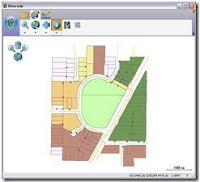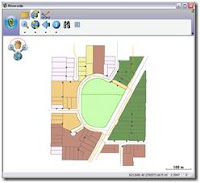In general, your applets written for ArcPad 7.1 will work without modification in ArcPad 8.0. However, there are some issues to be aware of to make this migration as clean and easy as possible for you and your users.
1. Toolbar images
Toolbar images have been supported since ArcPad 6, but are not commonly used in Applet toolbars.
ArcPad 8's tabbed toolbars make it much more important to provide toolbar images to help users quickly identify and switch to your Applet’s toolbars. If you don’t configure a toolbar image, ArcPad 8 will display a generic image.
Notice the difference in the user experience when using toolbar images vs. not using them in ArcPad 8:
2. "Built-in" toolbars and tools Prior to ArcPad 8, there were three built-in toolbars (Main, Browse, and Draw) with corresponding built-in tools.
If you wanted to add, remove, or re-arrange tools on these toolbars, you had to do the following:
· Hide the built-in toolbar(s)
· Create custom toolbar(s) containing the desired built-in tools and menus
· Add the custom toolbar(s) to your Applet or default configuration file (ArcPad.apx)
This required quite a bit of work - especially if all you wanted to do, for example, was remove one tool from the Browse toolbar.
With ArcPad 8, all toolbars are customizable! Out of the box, you will still the see Main, Browse, and Draw toolbars with their corresponding tools; however, these are no longer fixed.
You can use the ArcPad Toolbar Manager to re-define, re-arrange, or remove the default toolbars loaded when ArcPad 8 starts. The default toolbars are stored in
ArcPad.apx in your My ArcPad folder (below the My Documents folder).
Click Edit and then simply drag and drop tools onto or off of the desired toolbars.
3. The Quick Action tool

ArcPad 8 introduces the Quick Action tool.
It provides quick access to commonly used tools. Out of the box, it exposes a dropdown list of common tools and menus.This may or may not be appropriate for your Applet. Not to worry - like the "default" toolbars, the Quick Action tool can be easily re-defined or removed.
To re-define the Quick Action tool:Use the ArcPad Toolbar Manager to drag and drop tools onto or off of the QuickAction tool.
To remove the Quick Action tool:There is a property to hide the Quick Action tool in the ArcPadPrefs.apx file.
In general, the easiest way to configure properties for ArcPad to use with your Applet is to set the desired properties in "vanilla" ArcPad, and then deploy the
ArcPadPrefs.apx file that gets created/updated.
For the Quick Action tool, tap the small arrow in the lower right corner of the toolbars, and uncheck QuickAction.
Or, if you're an XML junkie, go right to the ArcPadPrefs.apx file in a text/xml editor and set the applicationbutton attribute to be "false" in the TABBAR element:
...
<DISPLAY>
<MAPNAVIGATOR/>
<TABBAR
applicationbutton="false" dock="top"/>
<SYSTEMTRAY/>
</DISPLAY>
...
4. The Open Map dialogArcPad displays a friendly Open Map dialog on start up to help guide the user and get him or her started. Like the Quick Action tool, this may not be appropriate for your users.
There is a setting to suppress this dialog in the ArcPad Options dialog, General page; however, that approach cannot be used for mass deployment. This setting is not stored in ArcPadPrefs.apx, but is one of the few settings stored in
ArcPad.ini on desktop and the
registry on Windows Mobile.
· The desktop ArcPad.ini file is stored in C:\Windows.
The setting to suppress the dialog is:
[Startup]
ShowStartupDialog=0
And to show the dialog:
[Startup]
ShowStartupDialog=1
· On Windows Mobile, the registry key is:
HKEY_CURRENT_USER\Software\ESRI\ArcPad\Startup
The DWORD value is: ShowStartupDialog
0 = No
1 = Yes
5. Default loading of ArcPad modulesIn ArcPad 7.1, all extensions (including built-in modules like TSIP and JPEG) are loaded automatically when ArcPad starts.
ArcPad 8, however, only loads the most commonly used extensions on start up by default. This is done in order to conserve available device memory for working with your data faster.
If ArcPad with your Applet depends on additional or fewer extensions, you can modify the extensions that are loaded automatically (or even load none at all).
The settings are stored in
ExtensionPrefs.apx in your My ArcPad folder (below the My Documents folder).
The easiest way to configure this file is via the Advanced Settings dialog, Extensions page in ArcPad.
Again, if you're an XML junkie, feel free to edit this XML file directly.
6. Bugs foundWe always strive to be bug free, but occasionally bugs make their way into a release. We've identified the following issues as new bugs in ArcPad 8.0. Please be aware of these and update your code as necessary.
CQ00311090: Setting Map.Scale property crashes ArcPad 8 (but not 7) on mobile device
CQ00311091: New in AP 8: Map.Layers(x) returns an invalid Layer object when x not present





















 News Feed (Atom)
News Feed (Atom)